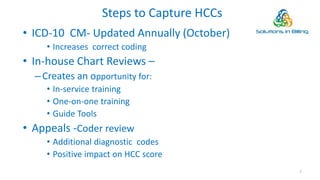Solutions In Billing 3
- 1. Hierarchical Condition Category By Cheryl A Macias, MHA/Inf, CPC 1
- 2. Hierarchical Condition Category Did you know? âĒ That currently, CMS uses the CMSâhierarchical condition category (CMSâ HCC) model to risk adjust MA payments. This model uses beneficiariesâ demographic characteristics and medical conditions collected into hierarchical condition categories (HCCs) to predict their costliness âĒ Physician groups, along with the MA plans with which they work, stand to collectively lose significant dollars in revenue if they don't quickly learn how to adapt to the new environment. 2
- 3. Purpose of Risk Adjustment âĒ Risk Adjustments allows CMS to: â Pay plans for the risk of beneficiaries enrolled â Replaces âaverageâ amount for Medicare beneficiaries â CMS increases the accuracy of payments (health status & demographics) Medicare Managed Care Manual Chapter 7 Risk Adjustment (Rev. 118,09-14-14) âĒ Statutory & Regulations Authority â Medicare Advantage Plan âPart A & B Title XVIII of Social Security Act âĒ Subpart G 42 CFR § 422.304 cms.gov 3
- 4. CMS Requirements âĒ Yearly Audit for Risk Assessment Conditions â Increase in number of Chart pulled for Audits â Review encounters spanning One Year â Reimbursement is based on supporting documentation within the Medical Record â Not because patient/member has a Chronic Condition 4
- 5. Steps to Capture HCCs Add some M.E.A.T. in your charting âĒ Monitoring-signs, symptoms, disease progression, disease regression âĒ Evaluating-test results, medication effectiveness, response to treatment âĒ Assessing/Addressing-ordering tests, discussion, review records, counseling âĒ Treating-medications, therapies, other modalities âĒ Stating [âhistory ofâ means the patient no longer has that conditions] 5
- 6. Steps to Capture to HCCs Accurate documentation & coding âĒ Offers the practice the ability to gain correct-Risk Adjustment Dollars âĒ Captured by the Providers documentation â Address all chronic conditions at least annually âĒ Code all illness addressed during Face-to-Face visit âĒ Code to the highest level of specificity âĒ Patients with Ostomy or Amputation â Ensure your provider addresses the status during the office visit âĒ This allows the Diagnosis to be coded 6
- 7. Steps to Capture HCCs âĒ ICD-10 CM- Updated Annually (October) âĒ Increases correct coding âĒ In-house Chart Reviews â âCreates an opportunity for: âĒ In-service training âĒ One-on-one training âĒ Guide Tools âĒ Appeals -Coder review âĒ Additional diagnostic codes âĒ Positive impact on HCC score 7
- 8. Steps to Capture HCCs âĒ Electronic Claim Submission â Initiate discussion with your Electronic Data Interchange Vendor âĒ Receive reports on rejected items â Validate maximum number of diagnosis transmitted âĒ To receive accurate Reimbursement â Validate your claim systems storage capability (diagnosis codes) Âŧ To capture and send all â ANSI837- claim format âsupports your HIPAA Compliance âĒ Question is this process capturing all relevant clinical information Âŧ Providers/EDI Vendors most times map to legacy transaction âĒ âthe original nine Dx codesâ and could possibly omitting ten and beyond- 8
- 9. Steps to Capture HCCs âĒ Research New Products â Track diagnosis data for âterminated patientsâ â Revenue can be recaptured âĒ From members who initially were on your monthly eligibility report , but may no longer appear since eligibility has ended. (lost revenue-worth while focus) âĒ Audit- for unprocessed data (backlog) âĒ New Patientâs â Could have assigned HCCs from prior Health Plan âĒ Incorporate plan on to maintain (as appropriate) moving forward as this will increase continuity of care and comprehensive data collection 9
- 10. ICD-10 Examples for HCCs âĒ Vascular Disease (HCC-108) â Manifestations of PVD including: ulcers, gangrene, claudication, cellulitis, & amputation status âĒ Artificial Openings for Feeding/Elimination (HCC-188) â Surgically created âostomyâ â Assign only complication code-attention to: adjustments or repositioning of catheter, closure, reforming, &/or removal/replacement of catheter 10
- 11. ICD-10 Examples for HCCs âĒ Morbid Obesity (HCC-22) â Is becoming a growing public concern âĒ Overweight, obese, morbid obesity- must be obtained from providerâs documentation and must include BMI, which can be coded from dietitian referral &/or counseling. 11




![Steps to Capture HCCs
Add some M.E.A.T. in your charting
âĒ Monitoring-signs, symptoms, disease progression, disease regression
âĒ Evaluating-test results, medication effectiveness, response to
treatment
âĒ Assessing/Addressing-ordering tests, discussion, review records,
counseling
âĒ Treating-medications, therapies, other modalities
âĒ Stating [âhistory ofâ means the patient no longer has that conditions]
5](https://image.slidesharecdn.com/055cd306-4f97-44f2-81db-e4009be931da-160618164739/85/Solutions-In-Billing-3-5-320.jpg)






